by Editor | Aug 18, 2014 | Food
By Elena del Valle
Photos by Gary Cox
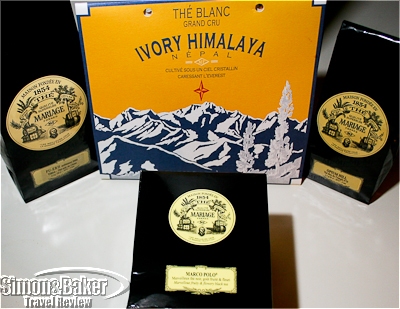
Our selection of Mariage Freres teas
Over the years we have sampled so many teas we’ve lost count. From plantations in India to gourmet tea shops in Paris, France and many places in between, tea has accompanied many special and memorable occasions.
Recently, we decided to sample a variety of teas over a few days. The idea was to dedicate our clean palates to tasting a single tea or two at most per sitting. The time and attention were meant to allow us an opportunity to explore the tea leaves and their color, tea fragrance and taste, and lastly the finish if there was one.
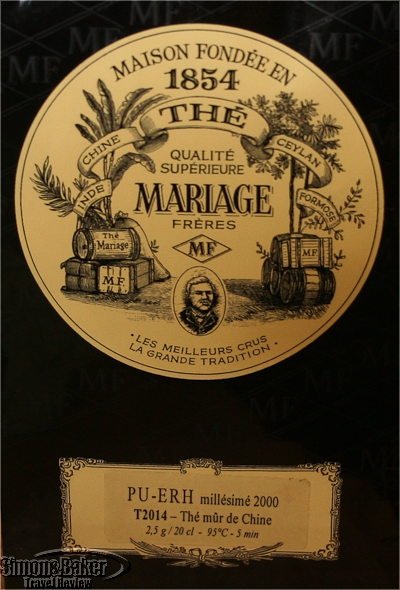
A closeup of the label showing brewing instructions
To compare apples to apples as it were all the teas we sampled were from the same shop, Mariage Freres Marais in Paris, France (Mariage Freres Marais, 30 rue du Bourg-Tibourg,75004 Paris, France, www.mariagefreres.com, info@mariagefreres.com,+33 1 42 72 28 11). Some we brought home with us and others arrived by post. The shipping caused some unpleasantness with the delivery company who tacked our small order with customs processing fees even though there was no evidence that customs officials viewed our package, and without ever obtaining our approval in advance.
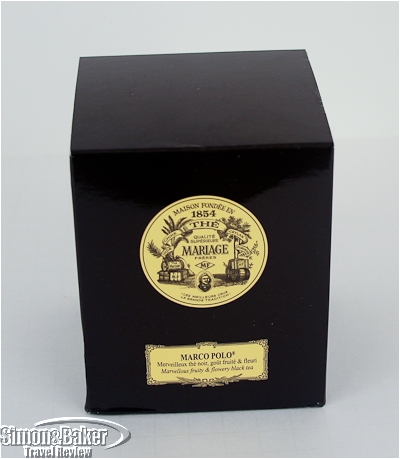
The Marco Polo tea came in a tin inside a box
We sampled the following loose teas: Ivory Himalaya The Blanc Grand Cru, Marco Polo Mervelleux the noir gout fruite et fleury (marvelous fruity and flowery black tea), Opium Hill The Bleu du Triangle d’Or (blue tea from the Golden Triangle), and PU-ERH millesime 2000 (vintage 2000) The mur de Chine (ripe tea from China). We also tried Sables au The Marco Polo (Marco Polo flavor sable cookies).
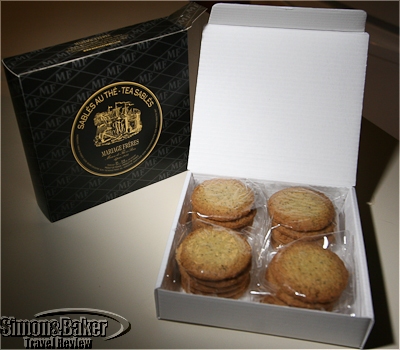
The Marco Polo Mariage Sables
The label on each bag, box or container provided instructions including the quantity of tea leaves per cup, the water temperature and the amount of brewing time. We followed the directions preparing the tea with bottled water and placing the tea leaves in individual cotton tea sleeves. We served the tea in a clear glass cup that allowed us to see the color of each tea.
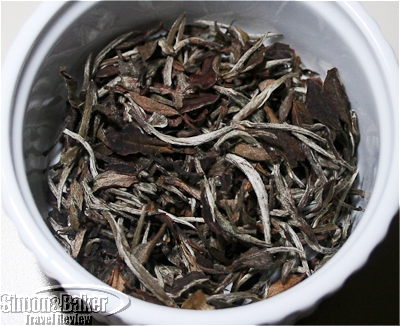
The Ivory Himalaya tea
The Ivory Himalaya white tea came in a plastic bag within a square carton which was sealed in an airtight wrapper. The tea weighed 20 grams. There was no visible expiration date on the package. The recommended serving was five grams of tea per cup brewed (one quarter of the package) for five minutes at 80 Celsius (below boiling). Sourced at a Himalayan plantation in limited quantities it was the priciest of the teas we sampled in that series.
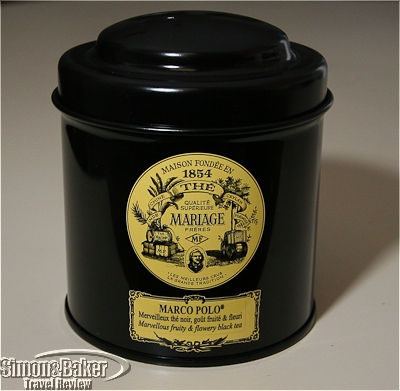
The Marco Polo tea in the tin
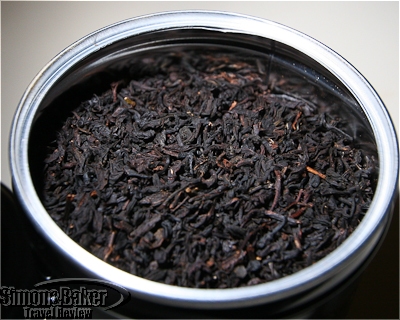
A closeup of the Marco Polo tea
The Marco Polo tea came in a pretty black tin containing 100 grams. The expiration date was January 2017. The recommended serving size was two and one half grams of tea per cup brewed for four minutes at 95 Celsius (below boiling). The tea leaves in the container had a distinctive fruity scent which was more pronounced in the brewed beverage. The tea was an appetizing rich medium brown which tasted of mild black tea with a slightly sweet fruit and flower taste. There was no finish of note. We tasted the Marco Polo cookies, made with wheat flour, sugar, concentrated butter, eggs and Mariage Freres Tea, at the same time as the eponymous tea. The buttery, crunchy and sweet cookies came in four plastic wrapped packets of five cookies each. The expiration date was August 2014.
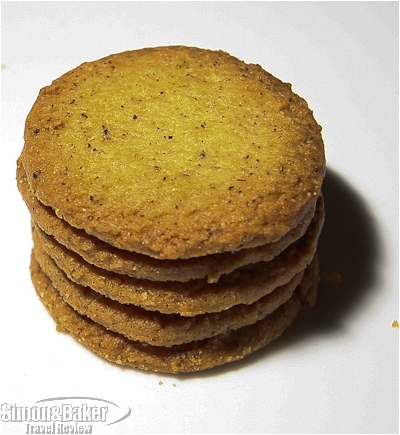
The Marco Polo cookies
The Opium Hill kernels came in a foil 100 gram bag and had an expiration date of January 2016. The recommended serving size was four and one half grams of tea per cup brewed for two minutes at 90 Celsius. Per the salesman’s instructions we infused it three times. He indicated up to seven infusions were possible from a single serving. The tea was pale green with a subtle green tea flavor. We couldn’t be sure if the color grew paler with each infusion. The scent was mild and made us think of green tea. The first infusion had a well defined taste. The flavor became less noticeable and more nuanced with each infusion while the finish became longer lasting and more pronounced. The idea that the third infusion had no theine held particular appeal for us. The third infusion, especially the finish, was a favorite.
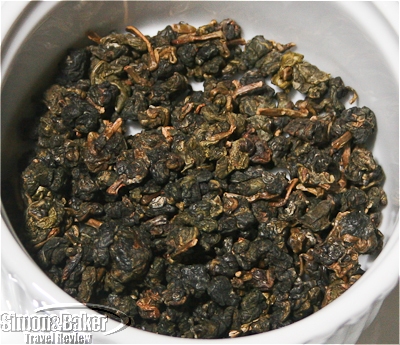
The Opium Hill Blue Tea
The PU-ERH came in a foil 100 gram bag which listed no expiration date. The recommended serving size was two and one half grams of tea per cup brewed for five minutes at 95 Celsius. The color was pale. While the scent of the leaves and the brewed tea were the strongest of the teas we sampled in that series the flavor was unexpectedly light. Words that came to mind were musty, smokey and dark all within a palatable range.
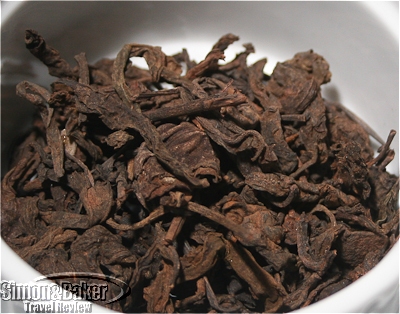
A closeup of the PU-ERH millesime 2000
The blue tea, reminiscent of green tea, was a favorite for regular consumption. Given its delicate flavor the Ivory Himalaya would be appropriate for special occasions or to share with friends. The nuances of the tea taste compared to the high cost were difficult to quantify, especially given the many fine tea choices available. On the other hand, the lingering finish on the palate was unequaled in that series and worth seeking out. To read about our tea and gourmet experience at the Mariage Freres Marais Paris tea shop, see Superb gourmet lunch at Paris tea salon
by Editor | Mar 10, 2014 | Books, Food
By Elena del Valle
Food photos by Gary Cox
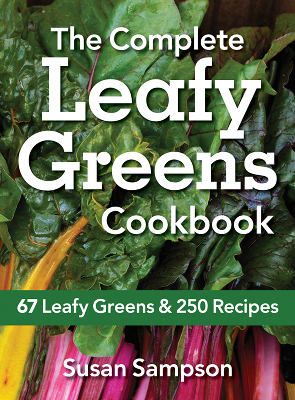
The Complete Leafy Greens Cookbook*
According to many reputable sources, leafy greens such as collard greens, kale, Brussels sprouts, Swiss chard and their kin are at the heart of a healthy and nutritious regime. For us, purchasing, identifying and eating greens has proved challenging at times. Becoming familiar with the different varieties and how to buy them was a first step. Next, knowing how to eat them to their best advantage requires additional effort and knowledge. Sometimes they are bitter, chewy or tough in their raw state. Other times they’re boring. Some leafy greens need preparation to become palatable. We turned to The Complete Leafy Greens Cookbook 67 Leafy Greens & 250 Recipes (Robert Rose, $27.95), a newly published cookbook by Susan Sampson, for information and recipe ideas.
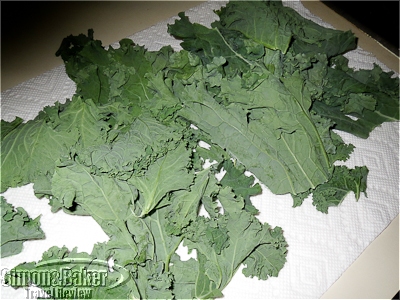
Kale leaves cleaned and ready to make crisps
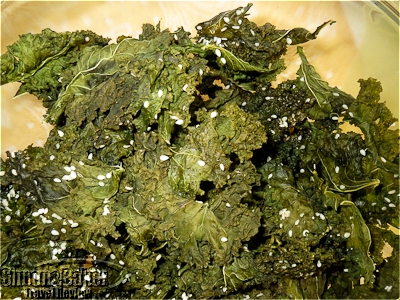
We made kale crisps with sesame seeds following a recipe in the book
The Complete Leafy Greens Cookbook is a softcover 480-page book filled with nutritional information, easy to read recipes and color photos. The leafy greens we wanted to learn more about were collard greens, baby bok choy and kale.
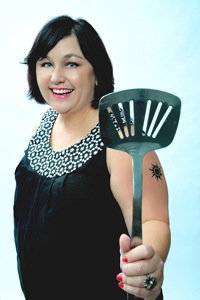
Susan Sampson, author, The Complete Leafy Greens Cookbook*
For example, we had been eating kale crisps for a while when we first came across the Cookbook. Its kale crisps recipe was similar to the one we were using. One of the options suggested in the book was to add sesame seeds. We tried it and liked it. The sesame seeds add a crunchy nutty flavor to the crisps and a twist to the everyday plain crisps.
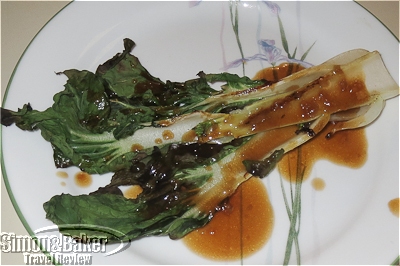
The grilled baby bok choy with soy glaze
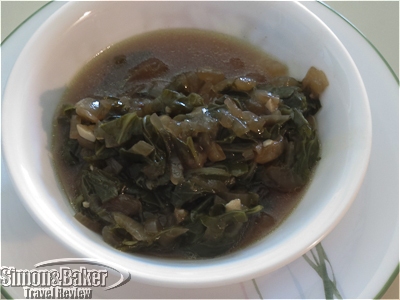
The collard greens cooked in beef broth while not pretty were delicious
We also sampled the Kaleslaw recipe. It required relatively little time and offered yet another way to supplement our diet with nutritious kale. The Old School Collard Greens were delicious (we used beef broth). Next, we tried the Baby Bok Choy with Soy Glaze recipe which required Shaoxing cooking wine. We grilled the baby bok choy on the barbeque grill instead of cooking it in a bowl as the recipe indicated. It was quite nice although the leaves were a bit chewy. Next time, we’ll slice the large ones into quarters instead of halves. The soy glaze seems promising to use in other dishes to add a dash of flavor. Although we excluded pepper, chili paste and spicy hot condiments from the recipes we prepared we liked them. They were all worth repeating.
*Photos: robertorse.ca

Click to buy The Complete Leafy Greens Cookbook
by Editor | Dec 23, 2013 | Food
By Elena del Valle
Photos by Gary Cox

The courtyard outside Le Chocolat Alain Ducasse Manufacture a Paris
The heady odor of chocolate was the first thing I noticed as we entered the Le Chocolat Alain Ducasse Manufacture a Paris, Manufacture for short, on a commercial street in Paris, France. Located in one of the city’s lesser known (to tourists) east neighborhoods the Manufacture, 320 square meters in size, was a modern chocolate factory in the back and a gourmet chocolate shop in the front. We left our winter coats behind and donned special white coats to enter the inner sanctum where the master chocolate maker and a handful of young men worked in harmony.
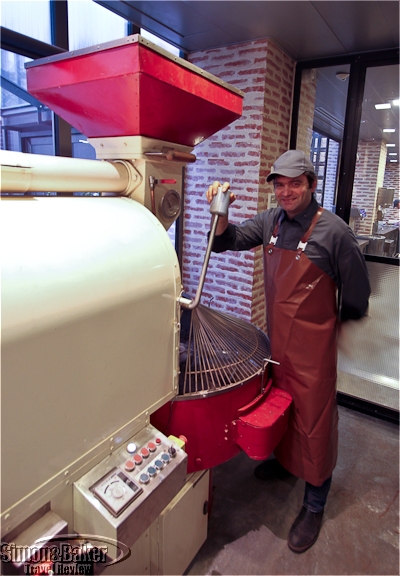
Nicolas Berger roasting cocoa beans
On a chilly morning, Nicolas Berger, the master chocolate maker, welcomed us warmly in the roasting room. For a short while he explained the process that transformed the raw cocoa beans from exotic locations across the globe into distinctive gourmet chocolates that stood out for their unique flavors in a city where a myriad shops sell fine chocolates. Prior to launching the Manufacture, Berger worked at Payard in New York City. He then joined the Alain Ducasse company as pastry chef at the Essex House also in New York. He later became executive pastry chef at the Restaurant Alain Ducasse at the Plaza Athenee hotel in Paris, France. Before that, he worked at Jean-Paul Hevin, Laduree, and Pierre Herme in France.
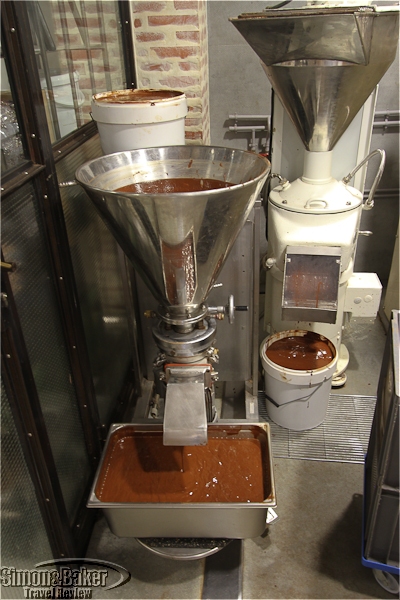
We watched chocolate being blended, smoothed and processed between roasting and the final product
He showed us the specialized equipment sourced with patience and effort and made in several countries: France, Germany, Italy and Switzerland. While we watched, he poured a container of 25 kilos of Madagascar cocoa beans into the toasting machine which processed 50 kilo batches at a time. A tiny amount of water was included in the process, he explained. The steam it produced killed any germs.
Bags of cacao beans marked with their country of origin stood like sentinels on the other side of the small room. A glass wall made it possible for customers to see the roasting room as they entered the courtyard that led to the boutique.
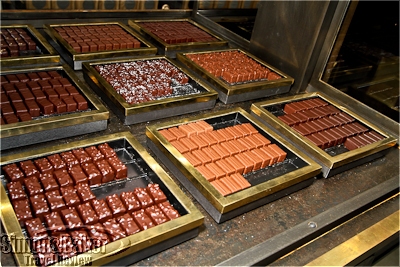
Trays of finished chocolates were displayed in the showroom
Following the roasting and separation of the shells and the beans in the roasting room the cocoa bean process continued in an adjacent area. The pure cocoa liquid went through several machines to be refined and blended with other ingredients, such as organic and biodynamic sugar from Brazil, and milk, depending on the outcome desired, into just the right consistency until eventually it was ready to be made into gourmet chocolate products. The initial refining process required about fifteen hours whereas the conching part of the process, which removed the thick gravely aspects, required at least twenty-four hours.
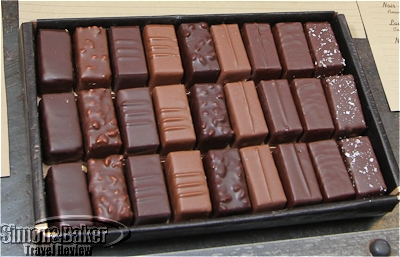
Fillings were coated, with great care, with a thin layer of chocolate
A variety of fillinging ran through an automated assembly line where each bite size morsel was coated with liquid chocolate. At the end of the line, staff removed the delicate product and prepared it for sale. Twenty-five flavors of individual chocolates were on offer. Production for December was expected to reach five or six tons. Nine staff, five in production and four in the shop, worked at Manufacture. While that might be a tiny amount in the chocolate industry where giant multinational companies produce huge quantities for commercial use and retail sale, it was the quality of the chocolate that we found impressive. We also appreciated being able to taste the classic single morsels of chocolate with filling in the place where they were made. More interesting at a personal level, was the variety of single source pure chocolates and how different the flavors where from each other.
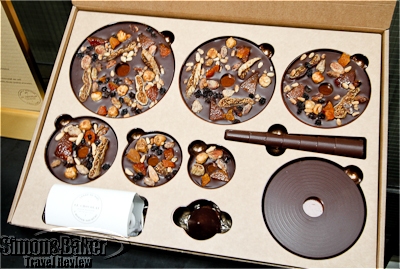
The shop offered a seasonal chocolate tree kit for the holidays
In the spotless shop, a central temperature controlled case with multiple glass covers that were operated by the staff was home to individual pieces of chocolate in a variety of flavors such as lime, praline, tonka bean and vanilla. As we selected the flavors we wanted to sample a staff person carefully removed one piece at a time and placed it on a ceramic plate.
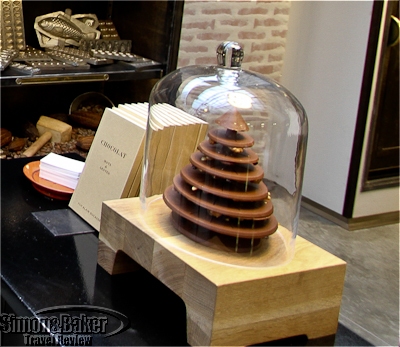
The tree was available in dark or milk chocolate. It could be assembled with the fruit and nuts facing up or down.
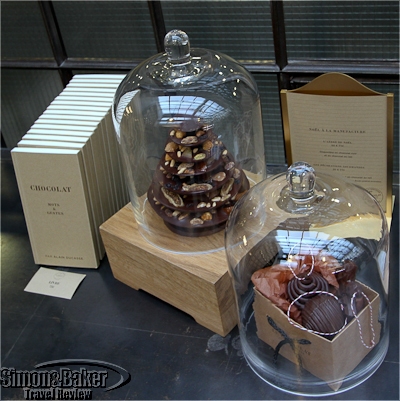
Left to right: The dark chocolate tree with nuts and fruit facing up and eatable dark chocolate Christmas tree ornaments
Along the left wall, there were sealed paper envelopes of single flavor chocolate bars from a variety of places of origin including Mexico, Peru and Venezuela, home of the well known Porcelana; Dominican Republic, Ecuador, Ivory Coast, Java, Madagascar, Sao Tome, Tobago, Trinidad, and Vietnam, all selected with care and emphasis on the quality of flavor (although the company made it a point of purchasing only cocoa beans harvested under fair labor practices), Berger explained with much enthusiasm.

The five single origin chocolate bars we sampled
The most popular single origin chocolate bar flavors were Porcelana du Perou 75 percent, Mendiant Almonds & Fruits dark chocolate and Perou non conche. A few days after our visit, we tasted five single origin chocolate bars of the 26 flavors available: Madagascar 55 percent milk chocolate, Madagascar 75 percent Ferme Bejofo Criollo chocolate, Peru 75 percent Trinitario, Sao Tome 75 percent Forastero Ameldonado, and Tradition Peru 75 percent non conche. We were surprised at how different the flavors were. In some ways, this chocolate tasting reminded us of a wine tasting. There were aspects of each bar we liked and subtle yet notable variations between the chocolates. Even the shade of the chocolate bars varied.
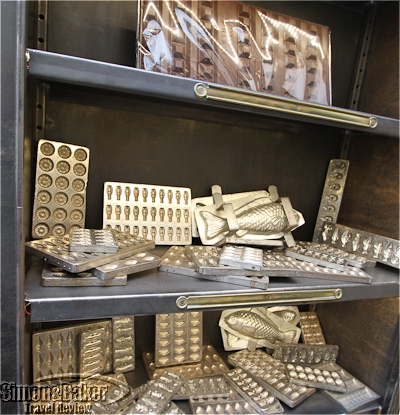
Chocolate and molds on display in the shop
While the Madagascar milk chocolate was smooth the dark chocolate from the same country had a hint of bitter and a slightly acid aftertaste. We thought there was a mild berry flavor in the Peru Trinitario which left a dry aftertaste. The Sao Tome had a rich, smoky flavor and a dry aftertaste as well. The non conche Peru bar was the most distinctive. Conche is a mixer and agitator that distributed cocoa butter within chocolate. Because that chocolate had not gone through the conching process it had a gritty texture. The flavor was full with dark and tart finish. One of us liked it especially while another liked it the least.
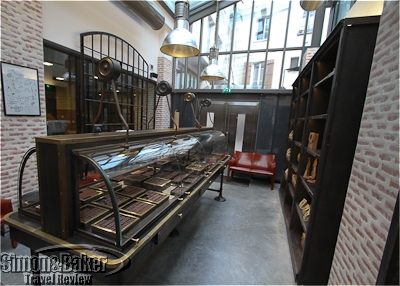
The interior of the shop
The nuanced flavors of the bite size chocolates are now fading in my memory. Fortunately, some chocolate bars survived the tasting. I will enjoy then while they’re still fresh and plan to revisit the shop at the next opportunity. When I’m in Paris again I’ll make a point of stopping by the shop to sample some of the flavors I didn’t have time to try and taste the ones I liked especially once again. As I think about it I liked all of the chocolate bar flavors so I may have to start from scratch. Le Chocolat Alain Ducasse Manufacture a Paris, 40, rue de la Roquette 75011 Paris, France, +33 1.48.05.82.86, http://www.lechocolat-alainducasse.com/en
by Editor | Oct 21, 2013 | Food, Luxury Travel
By Elena del Valle
Photos by Gary Cox
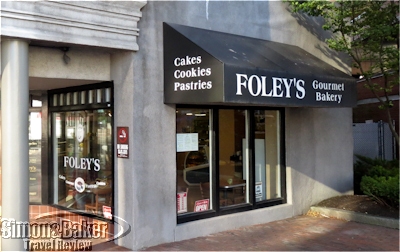
Foley’s Bakery is on the ground floor of an office building
On a crisp, cool fall morning in Portland, Maine we found Foley’s Cakes (Foley’s Cakes, 1 Monument Way, Portland, Maine 04101, + 207-773-CAKE (2253), http://foleyscakes.com), a small bakery and cake shop on the ground floor of an office building in the heart of the city. It was an easy walk from our accommodations. What drew us back regularly in a city with a high ratio of bakeries was the warm welcome from its owners and some treats that quickly became favorites such as the buttery and flaky ham and cheese croissants.
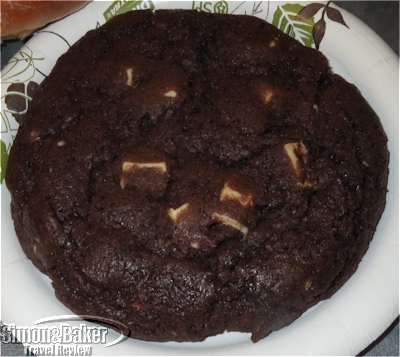
The reverse chocolate chip cookie was a favorite
We also became fans of the extra large cookies. We sampled the chocolate cookies with white chocolate chunks and the peanut butter cookies first. We loved the shop’s wholesome flavors and were especially pleased to discover everything they sold was made fresh from scratch on the premises without any artificial ingredients or preservatives. Increasingly we encounter stores and bakeries that sell products previously frozen or made or premade by someone else. Finding a bakery that sold only fresh products made onsite such as theirs was a pleasure.
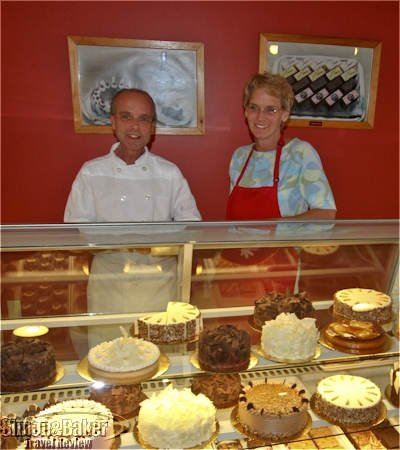
Ed and Molly Foley in front of one of the display cases
Pastry chef Ed Foley and his wife Molly were the owners of Foley’s Cakes, a European-style bakery established in 2011. Previous to that they had owned the original Foley’s Bakery also in central Portland from 1997 to 2002. He made all the well presented and appetizing baked goods sold at the shop facing Monument Square.
In a corner on the right side of the shop, there was a refrigerator with cold beverages and next to it a self service hot beverages section. As we sat at one of a half a dozen tables drinking coffee and tea and munching of croissants and cookies, we watched a steady flow of regular customers stream by, many buying baked goods to go. Molly greeted most by name. She seemed to know effortlessly what everyone’s favorites were from the child celebrating her birthday to the business executive with guests. By our second visit she remembered my preference for the white chocolate chunk cookies and my travel partner’s preference for the peanut butter ones.
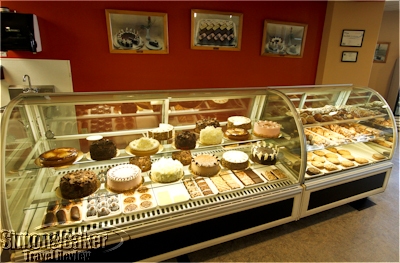
The tempting display of pastries
On display in two large cases there was a line of pastries, cookies, and cakes made on site. We could see the racks and baking equipment behind the cash register on the left side of the open room. Wedding cakes were also available according to the shop’s website.
“The fact that all of the baked goods are made from scratch plus the baked goods we offer are unique to Foley’s,” Molly said when asked what makes their shop special.
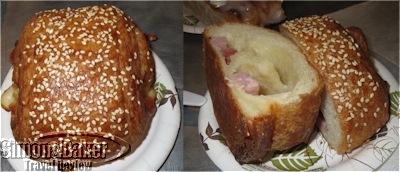
The ham and cheese croissant was a favorite
Chef Foley, with 20 years of experience, trained with European pastry chefs in the United States. Prior to opening his own shop he worked at The Grand Hotel, Mackinac Island, Michigan; Gasparilla Inn & Cottages, Boca Grande, Florida; The Tivoli Restaurant and Pastry Shop, Rosslyn, Virginia; and The Watergate Pastry Shop, Washington, D.C.; and was an instructor at the New England Culinary Institute, Montpelier, Vermont.
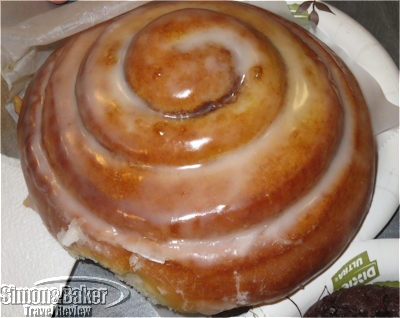
The cinnamon swirl
There were so many tempting cakes and pastries in the shop I left without sampling I’m hoping for a second visit to Maine’s largest city. For example, Foley’s best selling cake is the Marble Mousse Cake. It is made of two thin layers of chocolate cake with a thick layer of chocolate mousse, a thick layer of white chocolate mousse and a thin layer of pound cake covered in chocolate ganache.
by Editor | Jun 17, 2013 | Books, Food
Article by Elena del Valle
Photos by Gary Cox (except book cover and author courtesy of Sterling Publishing)
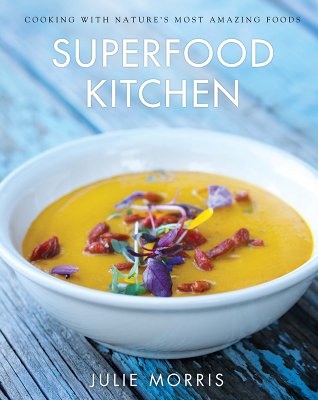
Superfood Kitchen book cover
When we first looked at the recipes in Superfood Kitchen Cooking with Nature’s Most Amazing Foods by Julie Morris (Sterling Epicure, $24.95) we were taken aback by the number of ingredients we were unfamiliar with and the difficulty in finding them in our suburban area. In the end, we had to shop at a number of stores and order part of the ingredients online. What we liked about the recipes we tried was their taste, simplicity and nutritional value. Morris is executive chef for Navitas Naturals, a superfood seller.
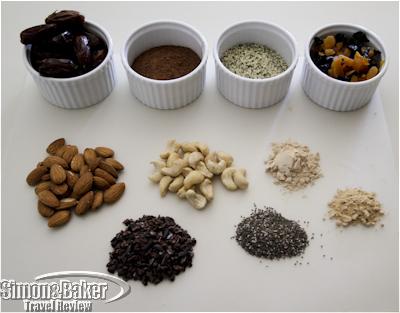
The energy bars required ingredients we had to buy
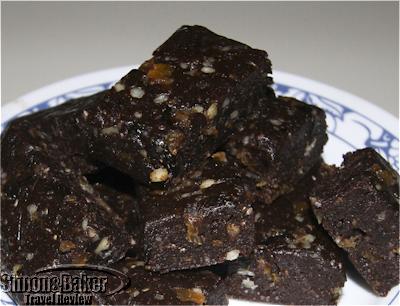
Our energy bars, made with superfoods
The 237-page hardcover book published in 2012 is peppered with color photos and divided into four main parts: Understanding Superfoods, Creating a Superfood Kitchen, Recipes, and Extras. Morris beings by defines superfoods as nutrient rich and beneficial for health and well-being. The idea behind her book, she explains, is to combine flavors and textures in a nutrient rich way toward a “collection of some very super parts.” She goes on to list and define the ingredients of the superfood kitchen and their nutritional benefits. Morris, a natural-food chef, advocates whole plant-based foods and superfoods.
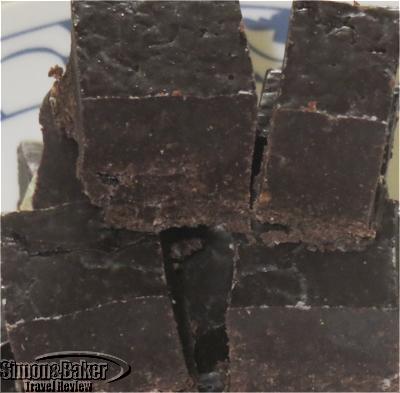
The Dynamite Fudge has become a favorite dessert
Cacao, she explains, is one of the most antioxidant-rich foods. It also offers “useful quantities” of iron and calcium as well as phytochemicals and amino acids that aid in elevating mood brain chemistry. It tastes like strong chocolate without the sweetness, she goes on to say, and improves when served with mesquite powder, carob, dates or ingredients with caramel flavors to soften the bitter edge.
She says maca is a root from the Peruvian Andes, and that Inca warriors relied on it for stamina and strength in battle. As an adaptogen, she says, the plant food may counter the different stresses of the body. It provides energy and combats fatigue, according to the book, without stimulating. It also offers sixty phytonutrients including sterols believed to help block cholesterol.
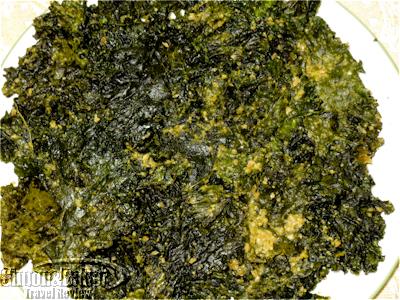
We often have kale crisps in between meals
To date we have tried four recipes: Chocolate Energy Bar from the Breakfast section, BBQ Sweet Potato Fries from the Sides section, Cheesy Kale Crisps from the Snacks section, and Dynamite Fudge from the Sweets section. On more than one occasion we adjusted the recipe to the ingredients we could find or to our preferences. For example, we left out the chili powder and cayenne pepper powder in the fries recipe.
The first time, we tried the fudge we substituted the maqui powder with additional quantities of the other ingredients in the recipe because we had been unable to find the maqui powder in our area. Eventually we received the maqui powder in the mail and made another batch of the fudge. We liked both fudge types, with and without the maqui.
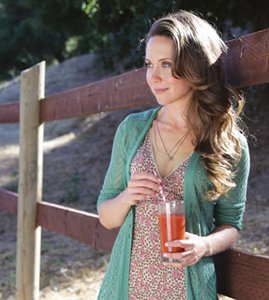
Julie Morris, author, Superfood Kitchen
The recipes we have tried have become regulars in our dietary rotation. We keep energy bars and fudge in the refrigerator and make fresh sweet potato fries and kale crisps the day we eat them. As time allows we plan on sampling additional recipes.
by Editor | Apr 15, 2013 | Attractions, Audio, Food
By Elena del Valle
Photos by Gary Cox
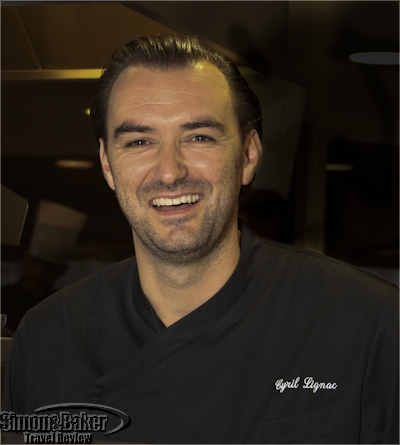
Cyril Lignac in the kitchen at Le Quinzieme Cyril Lignac
The week after dining at Le Quinzieme Cyril Lignac in the southwest corner of Paris we went across town to Cuisine Attitude (10 cité Dupetit Thouars,75003 Paris, France, +33 1 49 96 00 50, fax +33 1 42 56 15 46, www.cuisineattitude.com, ecole@cuisineattitude.com), a cooking school owned by Cyril Lignac, the restaurant owner and executive chef of Le Quinzieme, where we attended the first part of Christmas Petits Fours, a cooking demonstration with some student participation. While at the cooking school I had an opportunity to speak with the chef in English. We extend a special thank you to him for agreeing to a short English language interview. Click below to listen to our conversation.
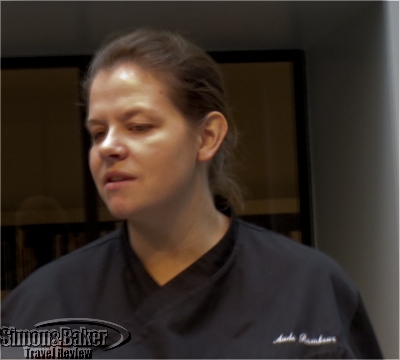
Aude Rambour, executive chef, Groupe Cyril Lignac
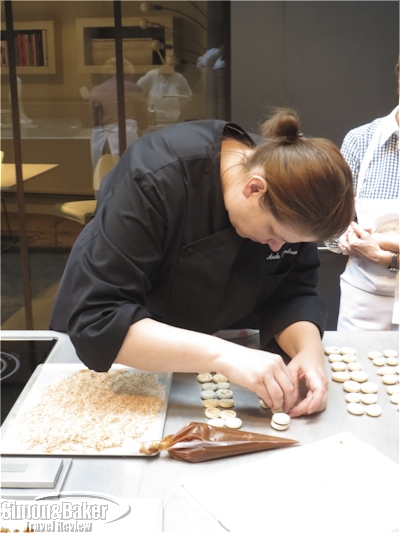
The executive chef demonstrating macaron assembly
After a brief welcome and introductions Aude Rambour, executive chef, Groupe Cyril Lignac, prepared the dessert dishes with the assistance of her staff. She explained the steps in French while a small group of French students observed. At times, she invited one or more of the students to take turns trying some of the steps. During the morning session, she prepared four desserts: Almond and dry fruits macaroons; Chocolate truffles, passion fruit; Candied chestnuts, light Bourbon vanilla cheese cream; and Tainori dark chocolate tart, Yuzu sorbet.
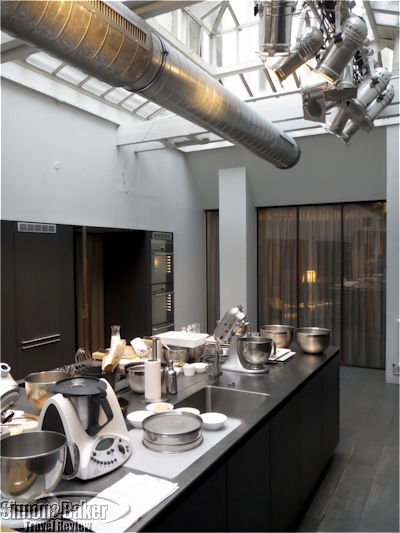
The teaching kitchen at Cuisine Attitude
Although the French language four hour program on holiday desserts was dynamic and fast paced, it was challenging to understand what was happening without any English language translation from the staff. We had understood someone would translate but the entire demonstration was conducted in French. A company representative informed us recently that an American chef has joined the group and is available to translate the sessions for English speakers.




















































